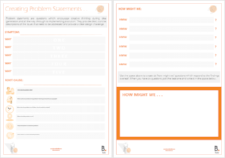“A problem well-stated is half-solved.”
In times of scarce resources it’s tempting when we spot something that isn't quite right to jump to conclusions and start thinking about potential solutions.
In our enthusiasm to get things done we can often miss the most important thing - a real understanding of the problem. Unsurprisingly this often leads to the implementation of solutions which fail to hit the mark.
A better approach is to step back and look a little deeper into the issue. One way to do this is with the use of problem statements. Problem statements are questions which encourage creative thinking during idea generation and all the way through to implementing a solution. They provide clear, concise descriptions of the issues that need to be addressed and provide a clear design challenge.
One way to arrive at a problem statement is through the use of a technique called the 5 whys.
By undertaking some quick discovery activity utilising ethnographic tools such as contextual interviewing and shadowing, as well as tools such as the 5 whys , it’s possible to see how what we think is a problem (the car breaking down) is actually a symptom of the root cause - the owner has failed to maintain the vehicle. By defining the root cause of the problem we can generate problem statements which allow us to design solutions which address the real issue at hand.
Using the above example, in order to design solutions which have real impact we therefore need to start by understanding why people fail to maintain their cars. By identifying key insights we are able to create a range of problem statements which in turn enable us to look at a range of possible solutions, moving from a silver bullet approach to a more customer focused and individualised ecosystem of ideas / solutions.
IDEO suggest that it is important that we define the problem in the right way - Too narrow and we limit the possible directions we can take during the design process. Too broad and we don’t have enough context in which to shape ideas. Arriving at the Goldilocks problem statement can therefore take a little practice and it can be useful to undertake the task in small groups, challenging each other to get the optimum scope.
Problem definition is an integral part of the Design Thinking process and is perhaps the most challenging part. However learning to master the creation of problem statements pays huge dividends. A well defined problem will kick start the design process in the right direction and will bring both clarity and focus to the design work.
-----
View on SlideShare
Download our template





